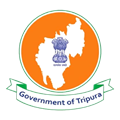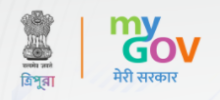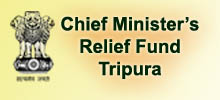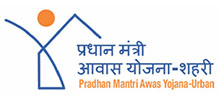Different Tribes of Tripura

Bhil : Tribes of Tripura
Bhills are considered as one of the oldest tribe in India. Once they were the ruler in parts of Rajasthan, Gujarat, Malwa, Madhya Pradesh and Bihar. They are a cross section of great Munda race and a wild tribe of India. Bhills could be identified as one of the Dravidian racial tribe of Western India and belong to Austroloid group of tribes. They speak a language of Dravidian origin. In Tripura total Bhill population is 2,336 as per 2001 Census. This tribe has migrated to Tripura from central India mainly from Bihar and Madhya Pradesh. Their economy is centralized with Tea garden, Brickfield and Agriculture. Their major concentrations in Tripura are mainly in Akinpur of Belonia, Bagan Bazar of Khowai Sub-Division. They are also found in North Tripura working in Tea gardens. Bhills are Hindus by religion. They appease deities of forest and evil spirits beside pujas of Lord Shiva and Durga. Small percentages among them follow Christianity. They cremate their dead followed series of rites as per their traditional customs and believe. Bhills are also fond of dance and music with traditional tune of Flute and Drum. In all family and community ceremonies they enjoy whole night by drinking and dancing. Bhills in other part of the country are well literate and enjoy modern weave of life.
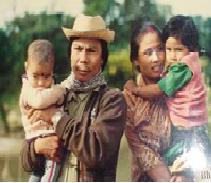
Bhutia : Tribes of Tripura
Bhutias are Himalayan tribe and negligible in Tripura. They are similar to that of Lepchas in terms of racial identity, Linguistic affinity and religious activities. In Tripura Bhutias once were used to be engaged in the Royal Army for their warrior character and physical strength. But in course of time they left Tripura to their original homeland. Presently under 2001 Census they are only 29 persons in Tripura. Most of them in Tripura are in Govt. job like paramilitary. Few families are however permanent residents of Tripura. Their relatives also reside outside the State.
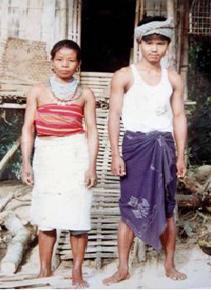
Chaimal : Tribes of Tripura
Chaimal is a smallest tribal group of Tripura. As per 2001 Census, their total population is only 226 persons. Their main concentration is at Ambassa of Dhalai District. They call themselves as "Saimar". Chaimals belong to the Cocaso-Mongoloid origin. They speak in a language originated from Kuki-Chin group of language. Chaimal language has no difference with that of Halams. They can understand and speak Kok-Borok, Chaimal live on Jhum cultivation as well use plain land cultivation. They are Hindus and follow all rites and rituals as per Hindu customs. Like other tribes, they have separate form of dance, folk songs and music though performances are very occasional.
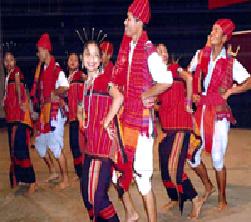
Chakma : Tribes of Tripura
Chakmas are one of the major tribes of Tripura according to their population strength. Chakmas are known to be a tribe of South-East Asia. They have first migrated to Arakan Hills of Burma and then Chittagong Hill Tracts to Tripura. A major part of them however migrated to Mizoram and Arunachal Pradesh in course of time from their original homeland. According to Census Report of 2001 Chakma population in Tripura is 61,793. Among Chakma there are 3(three) major groups like (i) Anokia, (ii) Tandugia, and (iii) Mangla. Linguistically Chakma language is mixed with loan words of Indu-Aryan language, Tibeto-Chinese and mainly Arakan language. Their language also be described as broken Bengali and Assamese language. Chakma have their own script in Burmese Alpha bets, though not in use rather Bengali script is being used and easy to learn. Economic activities of Chakmas are centralized with jhum cultivation, plain land cultivation and economic supporting works of vegetable growing. Fishing and wage earning. Chakmas are also ex-pert in trapping animals. They are well known for trapping wild elephants. In Tripura, especially in Gandacherra, a large number of Chakmas live as fisherman and also as boatman in Dumbur water areas.
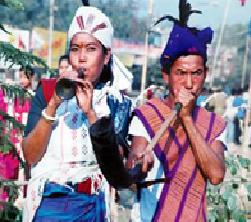
Garo : Tribes of Tripura
Basically Garos are one of the immigrant tribe in Tripura. Their original homeland were at Meghalaya (Garo Hills), Kamrup, Goal Para etc. places of Assam and Mymansing of Bangladesh. Migration of this tribe took place during the 1st half of 19th Century. Their major migration took place after 1950. At present their population is 11,180 in Tripura. Their major concentrations are at Udaipur Sub-Division and Sadar Sub-Division of Tripura. Ethnically Garos are a tribe of Tibeto-Burman linguistic family and under Mongoloid racial stock. They are very much familiar with the tribes like Bodo-Cacheries, Ravas, Mikir and other North-East tribes. Garos are matrilineal tribe. The mother in the family is treated as authoritarian head of the family. Property right therefore goes to the next daughter of the family. Garos are Hindus by tradition. Their socio - religious culture are therefore most akin to Hindu faith and practices. But for the last 50 years they in large scale converted their faith of religion towards Christianity. Garos wan-gala festival has great importance in their life. When new crop penetrates their granary, the whole community celebrate this wangala festival with colourful dance, songs and music. The long hand drum and other traditional musical instruments of Garos are really praise worthy and tune of these instruments are so melodious that these creates an eternal feelings in mind.
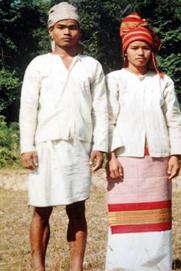
Halam : Tribes of Tripura
Ethnically, Halam belong to the Cocase-Mongoloid origin of Kuki-Chin tribes. Their language is also more or less similar to that of Tibeto-Burman family. Halams are also known as Mila Kuki, though they are not at all Kukis in terms of language, culture and living style. Halams are divided into several sub-clans which is referred as "Barki-Halam". Major sub-clans of Halams are (1) Kaloi, (2) Kor-Bong, (3) Keipeng, (4) Bong, (5) Saka Chep, (6) Thanga chep, (7) Dab, (8) Bongser (9) Rupini, (10) Hrangkhawl, (11) Chorai, (12) Langai, (13) Kaireng, (14) Ranglong, (15) Naveen and (16) Khulang. Among these tribes, as per 2001 Census their total population is 47,261 and distributed through out the State.
Halams are basically Hindus and followers of Sakti-cult though Vaishnavism is spreading among some of the sub-clans like Murasingh, Rupini and Kaloi. But Christianity is also being embarrassed by Halams.
Halams major concen tration are in Kamalpur, Sadar East, Molsom Bari and Kwipilong of Udaipur, Ampi, Ambassa etc. places of different Sub-Divisions. Among Halams Kolai, Murasing, Rupini speak in Kok-Borok and their social and religious culture also similar with Tripuris.
Halams live in typical "Tong Ghar" specially made of bamboos and Chan grass. Apart from plain land cultivation they still practice Jhum cultivation and depend on both the activities beside other substitute works.
Marriageable age among Halams 21-24 for boys and 18-20 for girls. As per traditional customs they still honour their customary laws in setting up of marriage alliances. They have their own social institute and village council. The council looks after and sorts out most of the social disputes over land, crime against women and children.

Jamatia : Tribes of Tripura
Jamatia is another tribal group of Tripura, having distinct feature of Mongoloid Origin. Their language is also similar with that of Tripuris. So they speak in Kok-Borok, which is a language of Tibeto-Burman family. As per 2001 Census their population in Tripura is 74,949 and treated as 4th largest tribal group of Tripura.
Jamatia were the major strength of Royal Army of Tripura kingdom for which they were exempted from the house taxes during princely- state. Earlier Jamatias had to live on Jhum Cultivation. But among the tribals of Tripura they accustomed themselves with plough cultivation after the Tripuris. At present most of them depend on plain land cultivation beside allied economic activities.
Jamatias are Hindus and have embraced Sakti cult and Vaishnavism. "Hoda Akra" is their supreme traditional Social Institute, which has power to look after to preserve and promote their every Social taboos, Customs and religion. All sort of social and criminal disputes in between the community members are also sorted by the 'Hoda'.
Jamatias are fond of their traditional folk culture and observance of those components like Drama, Garia festival and other common dances of Kok-Borok speaking tribes. They have special from of Garia dance which denote their Hindu based religious culture. A large numbers among them follows Vaishnavism and observe all events as per tradition
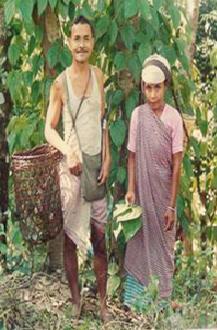
Khashia : Tribes of Tripura
Khasias belong to Austro-Asiatic racial stock and their language could be grouped under Mon-Kher groups of language. They are famous for their matrilineal society.
Socially Khasias are Meghalayan tribe. In Tripura they are only 630 persons as per 2001 Census. They live mainly at Kailashahar and Dharmanagar. In true sense, Khasis have no ethnic relation with other Tripura tribes. They are staying here from 18th Century for economic reason. The Khasis in Tripura have their own garden of Betal leaf, which is popularly known as "Khasia Pan". Other than this plantation work they used to rear large number of cattle.
By religion, Khasis were Hindus but from last part of 18th Century most of them embarrassed Christianity and follow the religious activities beside their amnesic rites and rituals. Their cultural life also has an important component of Indian Culture.
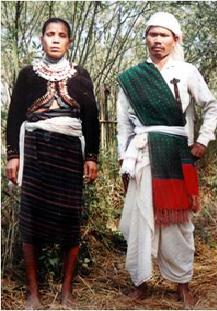
Kuki : Tribes of Tripura
Kuki is a word pronounced by outside people to refer a group of tribes like Darlong and Lusai. The Lusai of Tripura used to live in Jampui and Shakan Hills of North Tripura. They call them as Mizos. They never call them Lusai as the word 'LU' means Head and 'SAI' means cutting (Head Hunter). Though once they were treated as headhunter.
Darlong is another tribe known as Kukis. All together Kukis are 11,674 persons in Tripura. They live in hill top and maintain their livelihood through Jhum Cultivation and producing fruits. now a days they also accustomed with plain land cultivation and rearing of animals. Kukis are very much expert in hunting of wild animals. They eat meat of any kind with pleasure. Linguistically they speak a language originated from Kuki-Chin linguistic family and they have so many clans.
Kukis are fond of music and dance. They work hard in jhum field and enjoy dance and music at community level. They do not arrange any marriage alliances outside their community. Tradition-ally they were not Christian. They had faith on lord Shiva beside different deities and spirits. But for the last fifty years majority of them have embraced Christianity.
They have their own customary laws and village council. LAL is a term to denote village chief. This is the reason for which Darlong use Lal before their name. The village Chief generally meets up all sort of social and religious disputes including dispute relate to marriage and divorce. Kukis presently a small tribe in the state and socio-economically more advanced tribe.
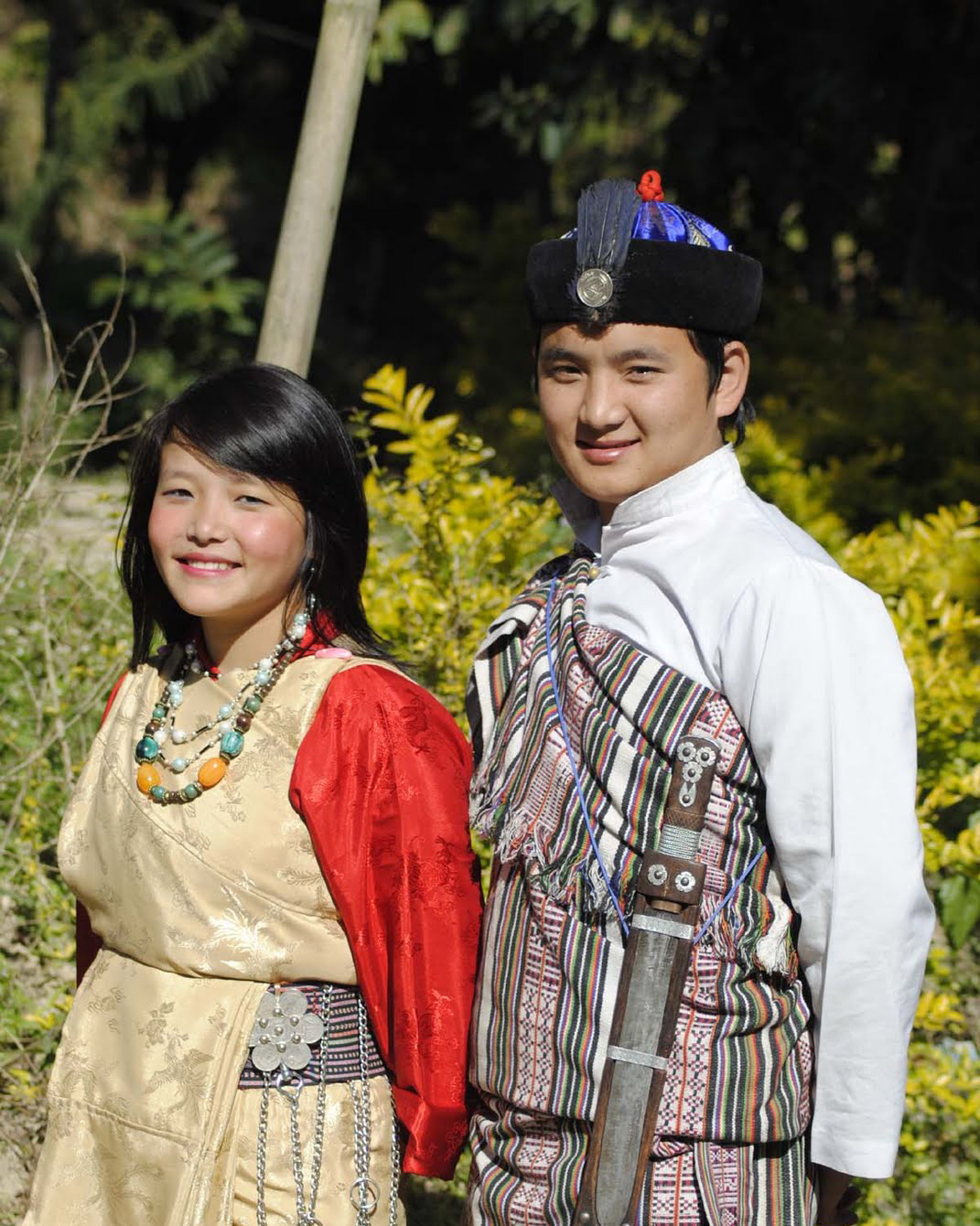
Lepcha : Tribes of Tripura
Lepcha is a tribe of Himalayan range live at the North-East corner of India. They largely resides at Meghalaya, Arunachal Pradesh, Bhutan, Sikkim and Darjeeling. They have also migrated in other North-Eastern States for economic reason.
In Tripura Lepchas are only 105 persons as per 2001 Census and mainly found in Dhalai District of Tripura. Lepchas are Mongoloid tribe. Their language is an admixture of Nepalees and Sikkims languages, which is very familiar with Indo-Chinese language. They themselves call "Rong".
Lepchas live on rearing large number of cattle and milking cows besides cultivation of Agricultural and Horticultural crops.
Originally Lepchas were the nature worshiper and had belief in witch-craftship and spirits. But in due course they embarrassed Buddhism. In Tripura they are known as Nepalees and their social and community relationship also bounded with Nepalees.
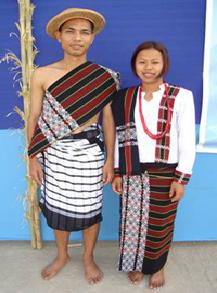
Lushai : Tribes of Tripura
Lushai (Mizo) is another tribe under Kuki-Chin group of tribes. Their main concentration is under Kanchanpur Sub-Division of North Tripura District. Lushais are commonly known as Mizos. Racially they are known to be under Mongoloid origin. In Tripura they are 4,777 persons as per 2001 Census. Most of the Lushai resides at Jampui Hill which is their homeland.
The main occupation of the Lushais are Jhum and orange Cultivation. They are also famous as orange producing community. Before others Lusai are known as Head Hunter community. During 1st part of 19th Century most of the Lusai's converted as Christian and still follow Christianity as their religion.
Their Bamboo Dance (Cheraw-dance) is very much popular in and outside the country. Literacy rate among them comparatively is higher then that of other minor tribes of Tripura. A large number among them could be found in Govt. jobs and other economic fields.
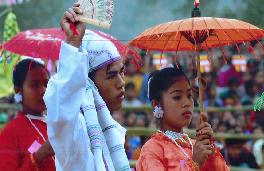
Mog : Tribes of Tripura
In Tripura as per 2001 Census Mogs are 30,385 persons. Their major concentrations are at Subroom and Belonia. Mogs are Arakan tribe and migrated to Tripura through Chittagong Hill Tracts. By religion they are Buddhist. Their language is grouped under Tibeto-Chainese family, which has also linked with Assam-Burmese section of language.
Mogs are depends on Jhum Cultivation. By nature they are no so much active for advancement of life. They have social Administrative social council. Chief of this council is called as Chowdhury. They cremate their dead after observing rites and rituals. Wah Festival is their annual meeting of whole community people.
There is a combination of folk songs and dance during this festival. In fact Mog's social culture and belief are centralized with Burmese culture. Their folk tales and folk songs are really mind blowing and touches core of heart. Mog community by tradition famous for their folk medicine. Beside their normal economic activities some of them earn through indigenous treatment/medicine.
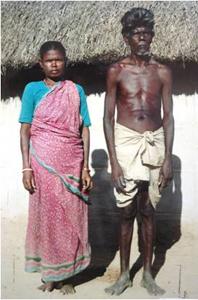
Munda : Tribes of Tripura
Mundas are the central Indian tribe and recognized as an immigrant tribe in Tripura. Original homeland of Mundas was at Chota Nagpur. Mundas are Proto-Australoid tribe. Mundari is their language, which is belongs to Austro-Asiatic family.
In Tripura Mundas were brought to work in Tea garden and in Brickfields during the 1st part of 19th Century by the then King of Tripura. Their present population is 12,416 as per 2001 Census and mainly concentrated at Kailashahar, Manu Valley Tea Estate and other Tea Estates in the State.
Mundas live in mixed villages with other tribes. They enjoy their life during working in Tea garden with community participation, group hunting with bow and arrows of wild animals and birds, group dancing and singing and also enjoying country liquor irrespective of age bar in any ceremony or festival.
Mundas are Hindus. They also have faith in their traditional deities. In every Munda village there would be three important features (1) SARANA, (2) AKHRA and (3) SASAN. Besides PAHAN (Priest) have an important role in the life of Mundas. Pahan look after all religious rites and rituals, community festival, marriage, treatment by appeasing village deities and funeral rites.
Mundas economy is so hazard that they still live on hand to month. They frequently depend on village Mahajan. Even then, lot of changes in their socio-economic life could be observed now a days.
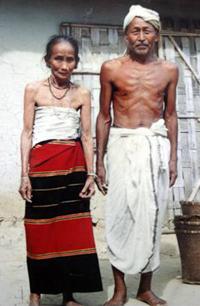
Noatia : Tribes of Tripura
Noatias are one of the important tribal groups in Tripura. Though they are a part of Tripuris still they are treated as 'New Comers'. In fact Noatias had been at Arakan Hill Tracts for a long time be-fore they have migrated to the South part of Tripura via Chittagong Hill Tracts. Ethnically Noatias have similar Origin of other Mongoloid tribes and their language is also Kok-Borok. It is said that Noatias is not their actual tribe name. They were actually Tripuris. Legend says that once a furious war was happened in between the then Tripura king and Arakan king. In that battle Arakan king took lead and captured hundreds of Tripuri army. They had to stay at Arakan. During their stay they had contact with the local tribals for which their language and culture were changed to some extent. Till now in the life and culture of Noatias influence of their old culture are still found in their physical structure, skin color, food habit, language, rites and rituals.
Noatias have 11(eleven) major clans. These clans are Anokia, Khaklu, Totaram, Murasing,Noatia, Deildak, Keowa, Garjan, Tongbai Kalicha and Aslong. Noatias are Hindus and observe all pujas and festivals as per their tradition and customs. Among them Vaishnamism also have great influence. They also observe Garia and Baisu festivals like other Kok-Borok speaking tribes.
In Tripura Noatias are concentrated in South Tripura and Longthorai Valley Sub-Division. As per 2001 Census their population in Tripura is 6655 persons. The main reason is that Noatias in course of time took title as "Tripura".
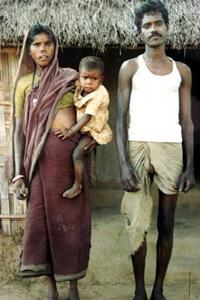
Orang : Tribes of Tripura
Orangs is an immigrant tribe, migrated to this territory from Bihar, Madhya Pradesh and West Bengal. This tribe in Tripura mainly resides in Sadar North and in major Tea garden areas. Orange is plain tribe. They mainly depend on Agriculture, Plantation works of Tea garden and as labourers of Brickfields. As per 2001 Census Orang are only 6,223 persons in the State. Orangs live in clustered village wherein there may be 30 to 50 families. They built their houses with mud wall, chan grasses and bamboos. They do not keep any window in their dwelling house and always keep their houses neat and clean.
Orangs speak in broken Hindi, which may be grouped under Australiod group of language. But in Tripura they do not speak in their language better feel smooth to speak in Hindi mixed Bengali, which have originated from Dravidian family.
Orang girls are fond to beautify themselves with silver ornaments and saries. They use flowers for hair dressing. Orang sardar of a village act as the chief of the village and look after the well being of their community people. Village priest also act as religious head and take part for settlement of marriage and marriage function. During the marriage, community feast is given by both the bride groom and bride parties wherein huge quality of liquor is consumed beside late night songs, music and dances irrespective age bar or men and women. Orang's "Jhumur Dance" is very much popular among all.
Orang cremates their dead after observing series of rites and rituals. Economically Orang is fully depends on wage earning by dint of physical labour. Among them literacy rate is growing and economic consciousness is also in progress. As such in every spare of life Orang tribe residing Tripura is taking part in the development activities of the State.
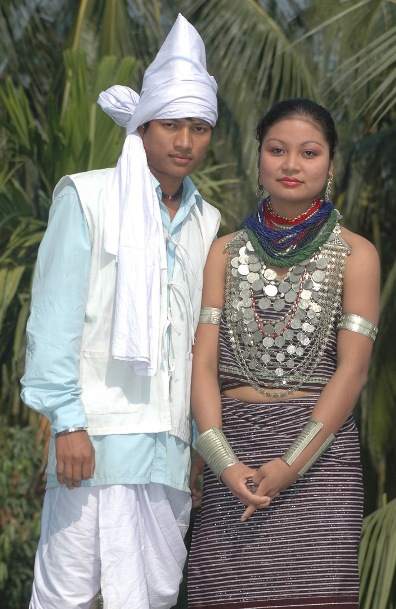
Reang : Tribes of Tripura
Reangs are the second largest tribal community of Tripura. They are recognized as one of the 75 primitive tribes in India. Numerically as per 2001 Census they are 1,65,103 persons in this State. Reangs are said to have came first from Shan State of upper Burma (now Myanmar) in different weaves to the Chittagong Hill Tracts and then Southern part of Tripura. Similarly another group entered Tripura via Assam and Mizoram during 18th Century.
Reangs belong to Indo-Mongoloid racial stock. Their language has affinity of Austro-Asiatic groups under Tibeto-Burman family. Ethnically Reangs are divided into 2(two) major clans (i) Meska and (ii) Molsoi. Their language is known as "Kaubru" which have a tonal effect of Kuki language though broadly it is Kok-Borok (language of men).
Reangs are still a nomadic tribe and a large numbers among them maintain their livelihood involving Top Hill Jhum Cultivation and other food gathering activities like collection of jungle fruits, leaf, plants, fishing in stagnant water in hill slopes, hunting of wild animals and birds etc. Naturally therefore, Reangs have faith on different deities like Buraha, Bonirao, Songrame, Jampira, Mangisiri, Lampra etc. There are also some female deities like Metaikotorma, Tuibuma, Mailoma, Ganga etc. Reangs, thus have believe in spirits and existence of soul. By religion they are Hindus and most of their deities are akin to god and goddesses of Hindu faith. Among Reangs followers of Vaishnavism are found in good numbers.
Reangs traditionally are endogamous and do not marry outside their community. The village council cheif is known as "RAI" permits Divorce and Widow Marriage. They cremate their dead beside a river or charra after observing series of rites and rituals and funeral procession.
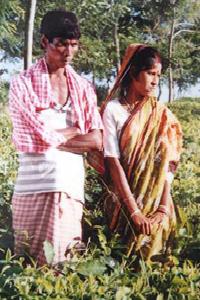
Santal : Tribes of Tripura
Santals are among the immigrant tribes in Tripura. They belong to Austro-Asiatic racial stock. Their original homelands are in west Bengal, Bihar and Madhya Pradesh. They have migrated to this state as Tea garden labourers. As per 2001 Census Santals are only 2,151 persons in Tripura. They mainly concentrated in Simna and Mechliban Tea Garden areas of Sadar Sub-Division and other places in the State. Their main occupation is to work in Tea garden area.
They are Hindus by religion and followers of Shakti-Cult. Holi is their main festival when they enjoy Haria (one sort of country liquor) and dance in-group with the melody of drum and sing-their traditional songs. Beside Santals have animistic faith being handed down from generation to generation. They have their priest who acts as religious head. Among them influence of Christianity is also not out of place.
Agriculture and Hunting of wild animals sustain their additional food requirement. In fact most of them do not have land. Land usually allotted by Tea garden owner outside the garden generally cultivated by them to produce paddy and vegetable.
Santals cremate their dead. The Christian Santals burry the dead. In case of death due to incurable diseases, accidental death or pre-mature death, bodies are buried. After cremation, bones and ash are brought in a grove over which a stone slave is placed in the memory of the deceased.The Santals are peace-loving tribe and live together with other communities in a peaceful co-existence.
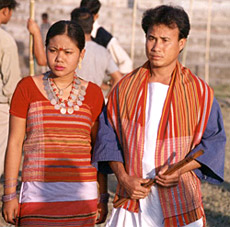
Tripuri : Tribes of Tripura
Tripuris are the largest tribal community in Tripura. They have first migrated in this territory and could be introduced as aboriginal tribe of Tripura. Numerically as per 2001 Census they are 5, 43,843 person in the State and Tripuris numerically highest in number among all the tribal groups. Tripura was under rule of Tripuri Kings till it is merged with Indian Dominion in the year 1949.
Ethnically Tripuris belong to Indo-Mongoloid origin and linguistically within the Tibeto-Burman family. They speak in Kok-Borok as like as other 7(seven) tribal groups of Tripura.
Tripuris are mainly Hindus. They follow both the ShaktiCult Vaishnavism. Beside they have belief in different deities, rites and rituals traditionally followed by them from time immemorial. Garia, Karchi, Ker Puja are their main festivals. They have colourful folk dances like, Garia, Lebang, Musak Surmani, Tangbiti and Mamita. These dances are invigorated with sweet molodies of folk songs and music of flute, Sarinda, Champreng and other string instruments.
Once Tripuri society was controlled by the regional social councils, which had power to exercise on over all social and economic disputes among the community members. In fact the chief of these councils were selected by the then kings of Tripura. But due to democratic set up, now a days, these councils have no existence. All sorts of minor problems are worked after by Village Panchayet or by other Legal Bodies.
Due to social transitions in all sphere of life particularly in the field of Agriculture, Socio-Cultural life, economic life, educational and health awareness, elite role etc. Tripuris are now treated as an advanced tribal community among the tribes of Tripura.
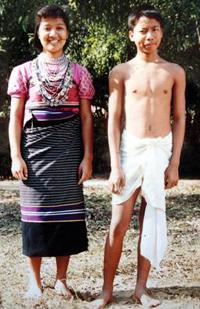
Uchai : Tribes of Tripura
Uchai is a separate tribe, live in Tripura since time immemorial. They have migrated in Tripura from Arakan Hills of Burma. As per 2001 Census Uchais are only 2,103 persons in this state and concentrated mainly in Amarpur and Belonia Sub-Divisions. Language and culture of Uchais are also similar with other Kok-Borok speaking tribes like Reang, Tripuris, Jamatias etc. Uchais also live in Tong (Gaireng) house built out or chan grass and bamboos.
Traditionally Uchais were Jhum Cultivators and still practice Jhum in high tillas and slopes. In Jhum they used to produce everything they needs. They still depend on many other economic and food gathering activities in the forest. They hunt wild animals, birds while work in jhum field.
Uchais live in clustered villages. In one village there may be maximum 50 families living together. In the family, irrespective of young and elder member, there exists a cordial and familiar relation. Major works in the family are generally done by mother. Father remains busy with economic activities. Women in the family including young boys and girls help their father and mother for works in the jhum field and other domestic works.
Marriage among Uchais held during the age of 16-20 yrs, previously there was a mandatory rule for staying of bridegroom in the house of father-in-laws before the final marriage and suitable bride price was to be given. But now a days this system is not prevalent. The social council of Uchais was very much rigid at one point of time but his type social institute is not so active now.
Uchais follow Hinduism in board sense. They believe in god and equally super natural forces. Their major deities are Radhak, Garia, Ker, Ganga Puja, Naksu Motai etc. Among them few families con-verted to Christianity and follow religious events as per Christian Calendar. According to Hindu religious thought, Uchais dispose their dead body by cremation after following rites and rituals and funeral procession.
- Back to previous page
- |
-
Page last updated date : 30-04-2024 01:39 PM

